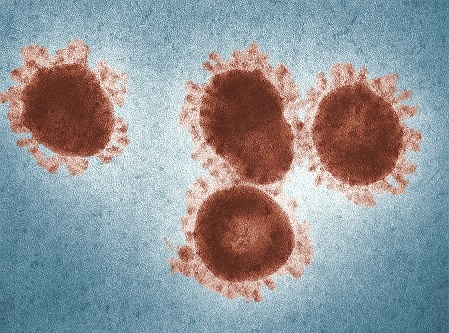Coronavirusurile nu sunt noi; acestea sunt la fel de vechi ca orice pe lume și se știe că provoacă răceală comună în rândul oamenilor de secole. Cu toate acestea, cea mai recentă variantă a sa, „SARS-CoV-2” este în prezent în știri pentru a provoca Covid-19 pandemia este noua.
Often, common cold (caused by coronavirus si alte viruși precum rinovirusurile) se confundă cu gripa.
Flu and common cold, though both present similar symptoms are different in the sense that they are caused by different viruși cu totul.
Flu or influenza viruși have a segmented genome which cause antigenic shift which occurs due to recombination among viruși of the same genus, thus changing the nature of the proteins on the viral surface responsible for generating immune response. This is further complicated by a phenomenon called antigenic drift which results from virus accumulating mutations (change in its ADN-ul structure) over a period of time that causes changes in the nature of surface proteins. All this makes it difficult to develop vaccine against them that could provide protection for long duration. The last pandemic of Spanish Flu of 1918 that killed millions of people was caused by flu or influenza virus. This is different from the coronaviruses.
Coronaviruses, responsible for causing Common cold, on the other hand, do not possess a segmented genome hence there is no antigenic shift. They were minimally virulent and occasionally lead to death of the affected people. The virulence of coronavirusuri is normally limited to cold symptoms only and rarely made anyone seriously sick. However, there were some virulent forms of coronavirusuri in the recent past, namely SARS (Severe Acute Respiratory Syndrome) that appeared in 2002-03 in Southern China and caused 8096 cases, resulting in 774 deaths in 26 countries and MERS (Middle East Respiratory Syndrome) that appeared 9 years later in 2012 in Saudi Arabia and caused 2494 cases, resulting in 858 deaths in 27 countries1. However, this remained endemic and disappeared relatively quickly (within 4-6 months), possibly due to its less virulent nature and/or by following proper epidemiological procedures for containment. Hence, no need was felt at that time to invest heavily and develop a vaccine against such a coronavirus.
Mai târziu variantă of coronavirus, nuvela coronavirus (SARS-CoV-2) seems to be related to SARS and MERS2 which is highly infectious and virulent in humans. It was identified first in Wuhan China but soon became an epidemic and spread across the world to take the form of pandemic. Was this rapid spread across select geographies solely due to the high virulence and infectivity caused by changes in the genetic constitution of the virus or possibly due to lack of timely epidemiological intervention by reporting to the concerned national/transnational authorities which prevented timely containment measures, thereby causing about a million deaths so far and bringing the world economy to the grinding halt.
This is the first time in the human history that the existing coronavirus reportedly underwent changes in its genome that made it into a highly virulent variant, responsible for the current pandemic.
Dar ce ar fi putut cauza o derive antigenică atât de drastică, făcând SARS-CoV-2 atât de virulent și infecțios?
Există mai multe teorii care circulă în comunitatea științifică care indică originea SARS-CoV-23,4. Proponents of man-made origin of the virus believe that the genome changes seen in SARS-CoV-2 would take am extremely long period of time to develop naturally, while other studies argue that it may be of natural origin5 pentru că dacă oamenii ar crea virus artificially, why would they create a sub-optimal form that is virulent enough to cause a severe disease but binds sub-optimally to the human cells and the fact that it was not created using the backbone of the known virus.
Be as it may, the fact of the matter remains that a certain almost innocuous virus underwent genetic changes to transform itself to become mildly virulent SARS/MERS, and finally into a highly infectious and virulent form (SARS-CoV-2) in a span of 18-20 years, appears unusual. Such drastic antigenic drift, which incidentally has a continuum in between, would be highly unlikely to happen in a normal course, in the laboratory of Mother Earth, in such a short time duration. Even if it were to be true, what’s more perplexing is the environmental pressure that would have triggered such a selection in the evoluţie?
***
Referinte:
- Padron-Regalado E. Vaccins for SARS-CoV-2: Lessons from Other Coronavirus Strains [publicat online înainte de tipărire, 2020 aprilie 23]. Infectează Dis Ther. 2020;9(2):1-20. doi: https://doi.org/10.1007/s40121-020-00300-x
- Liangsheng Z, Fu-ming S, Fei C, Zhenguo L. Originea și evoluția noului coronavirus 2019, Clinic de Boli Infectioase, Volumul 71, Numărul 15, 1 august 2020, paginile 882–883, DOI:https://doi.org/.1093/cid/ciaa112
- Morens DM, Breman JG, et al 2020. Originea COVID-19 și de ce contează. Societatea Americană de Medicină și Igienă Tropicală. Disponibil online: 22 iulie 2020. DOI: https://doi.org/10.4269/ajtmh.20-0849
- York A. Noul coronavirus își ia zborul de la lilieci? Nat Rev Microbiol 18, 191 (2020). DOI:https://doi.org/10.1038/s41579-020-0336-9
- Andersen KG, Rambaut, A., Lipkin, WI et al. Originea proximală a SARS-CoV-2. Nat Med 26, 450–452 (2020). DOI: https://doi.org/10.1038/s41591-020-0820-9.
***






































